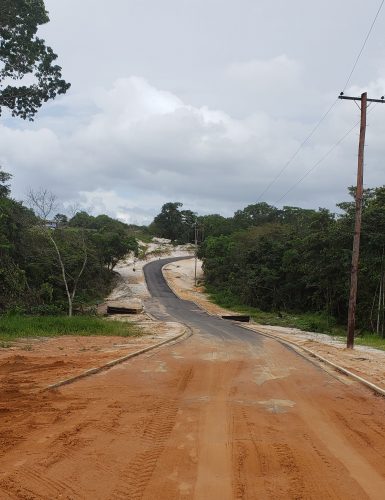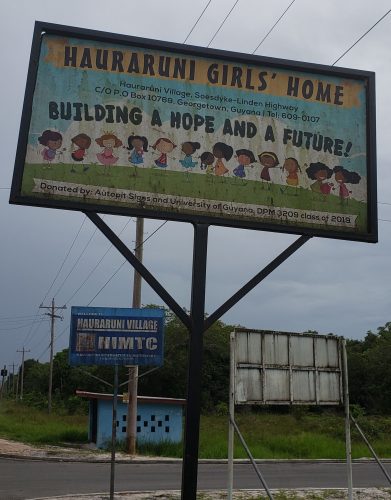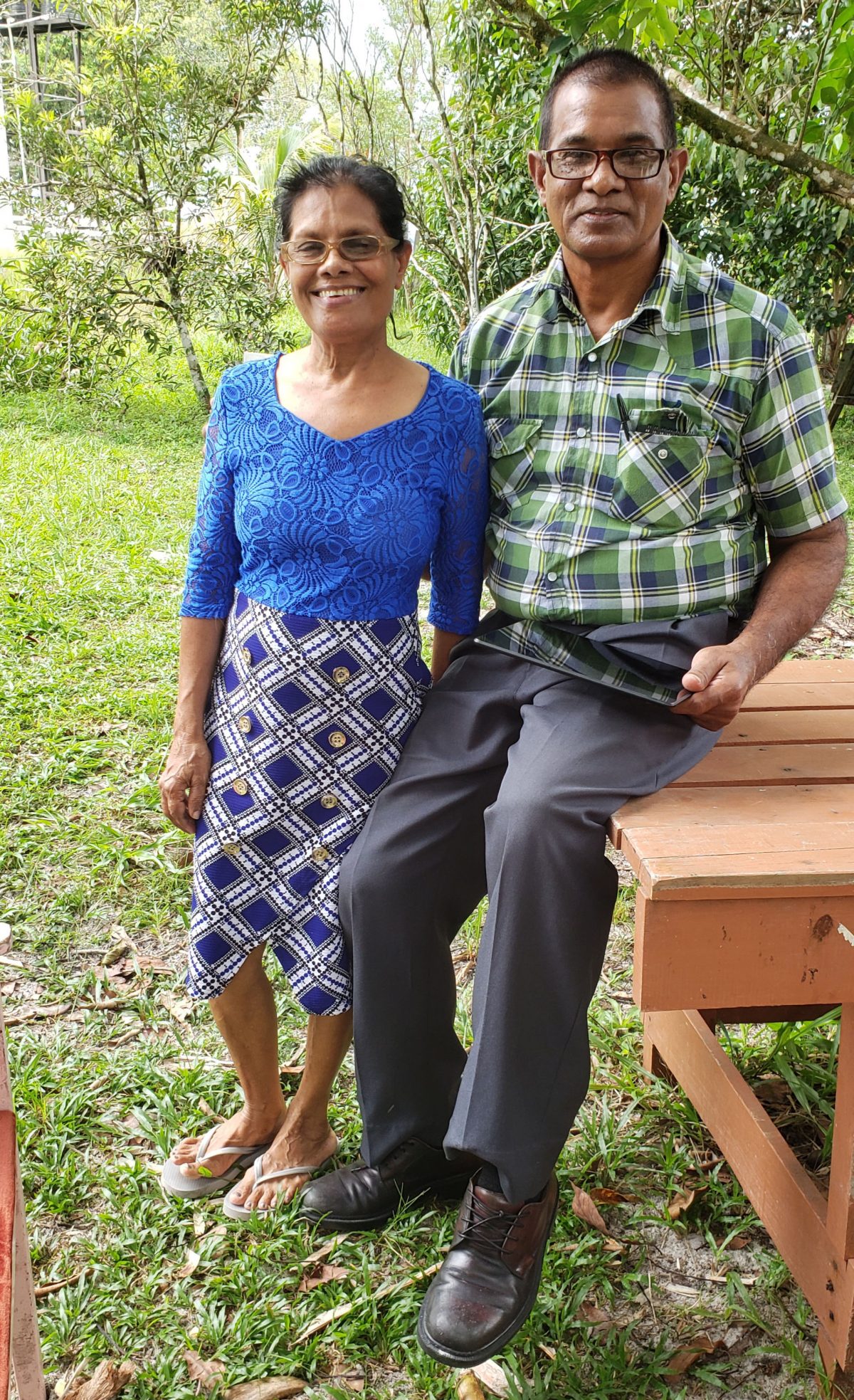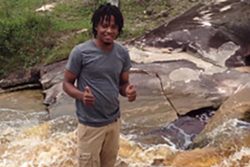Now 63, Deoram Timram was one of the pioneers who gave up the comfort of his home in the mid-1970s to create and nurture a new village that would support the Hauraruni International Missionary Training Centre at Hauraruni, found about a mile and a half off the Linden/Soesdyke Highway.
“In the beginning, I under-bushed, fell trees, raked up after burning, surveyed lands, cut roads, constructed buildings, repaired and maintained vehicles, burst fire wood, cut grass for cows, laid out water lines and electric lines to service homes, repaired and maintained water pump and generators, drove tractors, pulled and sawed logs, converted logs to lumber to help build the village,” Timram said.
In a recent interview at his home in the 460-acre Hauraruni community, Timram who was born at Number 60 Village, Corentyne, said he believed in the vision of Phillip Mohabir, the founder of the Hauraruni Full Gospel Cooperative Society Limited, to give members of the Full Gospel Church lands on which they could make their homes while supporting their pastoral missions.

“It did not matter which part of the country or the world you go to minister, you would always have a home to return to.” Today the close-knit village boasts about 35 homes.
Timram attended Number 48 Primary School and was in the first batch of students to enter the classrooms of Central Corentyne Government Secondary School when it opened its doors in 1969. On leaving secondary school with several subjects at the General Certificate of Education Ordinary Level, Timram worked with a house painting firm for a year before venturing to Hauraruni.
In 1974, he joined Number 48 Full Gospel Fellowship Church which gave birth to Hauraruni village. “I grew up in a Hindu family. I was the first in my family of nine siblings to convert to Christianity. My older brother

followed and then the entire family.”
In August 1975, Timram joined a group of young male volunteers from Lower Corentyne for his first camping experience at the Guyana Youth Aflame Campsite at Hauraruni, which he “thoroughly” enjoyed. In April 1976, he accompanied his pastor, Seeram Mohabir, Phillip Mohabir’s brother, to Hauraruni, where he spent a week with the students of the missionary training centre and helped to build round wood tables and benches for the dining hall. The founder had moved the missionary training centre from Stanleytown, Berbice to Hauraruni in March, 1975.
‘Blessed’
Timram met his wife, Janet at the training centre in 1975. They both graduated with diplomas and are full-time ministers.
“My wife has supported me 100 per cent. Without her I would not have been able to accomplish a quarter of what I have done. When we got married in 1980, we moved into a camp building without windows and doors. When we moved to where we now live, we had only completed the floor of the bedroom we were entering.”
In October, 1976, Timram became a student of the training centre where he was coursed in biblical and theological studies that involved both theoretical and practical aspects. “The practical aspect was like an apprenticeship programme. We learned various skills in preaching, evangelism, church planting and discipleship. We did carpentry, masonry, painting, gardening, mechanic, welding, sawmilling and woodworking. I am blessed to have been exposed to so many life skills that I continue to use to help others.”
In November, 1980, Timram began pastoring the churches at Soesdyke. He now pastors the church at Timehri.
In 2000, Timram and Janet began their missionary work in Region Nine – Upper Takutu/Upper Essequibo. “We started in North Rupununi at Aranaputa Valley, Yakarinta, Kwatamang, Simonie and at Crash Water in the Rupununi River. In Central Rupununi, we worked in Lethem and St Ignatius. Our main job is to train the leaders in the church and provide support. We trained the Indigenous Peoples to pastor in their churches. In the early days, we took pastors from the coast and it was disastrous. They did not understand the people’s culture.”
As a lecturer at the training centre, Timram lectures in New Testament survey and hermeneutics – the art and science of interpreting the scripture, communication skills and personal development and management.
Timram is also a marriage officer and a marriage counsellor. “The last marriage I presided over was my 100th,” he noted.
Hauraruni Girls Home
The home, which has accommodation for 25 girls between three and 18 years, was established in 1982 as a children’s home to take care of less fortunate children who were neglected or abused and who needed a home where they could be loved and cared for.
From 1995 to 2002, Timram was in charge of its administration. In 2007, he again took over the administration, before eventually retiring in 2020.
“We try our best to get the girls over the trauma they would have suffered. They come from all parts of the country and different cultural backgrounds,” he said before noting that with several children turning 18 soon and having to leave the home as a result “we have built an apartment, a half way home, adjoining our home where she and maybe a few more girls will stay before they go into the world.”
Timram and his wife, known to the girls as ‘Mom’ and ‘Dad’ or ‘Pops’ already had an 18-year-old living with them because she had no one to return to.
“We have started this process to put them on their feet, to help them finish or further their studies, to get a job. We won’t be able to take all of them but we are hoping that by example it would catch on and others would give these children who can’t go back home to a family member or a caring home.”
At the girls’ home, Timram said, he was administrator, driver, porter, handyman and repairman, counsellor and teacher.
By 2007, the management of the home and its infrastructure had deteriorated and Timram said the church’s national leadership said it was not bringing glory to God. “We had to either shut down or rebuild anew. Taking over, I had to fire staff and hire new ones. It was a tough walk to create new policies and implement them.”
When he was in charge, government gave the home a $100,000 stipend. That stipend has increased to $200,000 in recent years. To supplement the stipend, Timram sought sponsorship from businesses, donor agencies and individuals. P&P Insurance Brokers, National Milling Company, Massy Industries, and Food for the Poor came on board. Individuals from the United Kingdom such as David Plum and his family and Sally Murrcutt, Stanley Ming of Mings Products and Services, Fleurette King, Brian Jenkins of Chosen300, Amar Panday of Empower Guyana and Paramdeo Singh have all assisted.
“Friends, school mates from secondary school and classmates from our missionary training centre, all of whom I reconnected with on social media, assisted in one way or the other.”
In terms of infrastructure, Timram said, his assistant pastor, Trevor Williams, who was working with Digicel, entered a project proposal to upgrade the home in a competition involving groups of Digicel’s employees as part of their corporate social responsibility. At stake was a US$50,000 or G$10 million prize. Hauraruni Girls’ Home project proposal was submitted the night before the deadline. The submission was one of 17 shortlisted out of 173 entries from around the world. The girls’ home project proposal emerged the winner. Digicel’s contractors refurbished the entire home.
Church members also assist with a weekly collection set up for the girls at the home specifically to use for pocket money at school.
The website for the home – hauraruni.org – was launched with the hope of encouraging more people to partner and support the home,” Timram said.
Timram has served pro bono at the girls’ home and as a lecturer at the training centre. “Service is our life, our joy. Finances are not the main consideration for service. Our church supports us financially.”
Crazy to teach
While doing pastoral work, Timram also managed Hauraruni’s saw mill and furniture factory for a number of years. The factory supplied furniture to all the schools on the East Bank Demerara and further afield.
During that time, then Region Four education officer Maude Bullen-McKenzie visited, seeking persons from within Hauraruni to be trained as teachers for Hauraruni Primary School as the then headmaster and his wife who was also a teacher, were leaving. She said it was going to be difficult to find replacements.
“Only two of us were qualified. The other person was running the training centre. I had enough guys trained to run the factory. They gave me a week to make up my mind to take up teaching. In three days, I had made up my mind. I told my wife that I was leaving the factory and going into teaching.”
In 1989, Timram left the factory, which was paying him $1,200 a month, for a teaching job paying $500 a month.
“Everybody thought I was crazy, but I was thinking that my son and the other children needed an education and I could contribute.”
He started teaching in February 1989 and understudied the headmaster that month. On the headmaster’s departure, Timram acted as headmaster.
“I, young fellow without a clue about much of what I was doing, was attending head teachers meetings and preparing reports. Out of the blue, the then district education officer told me I was way ahead of some of the head teachers in reporting’.”
He taught until October, when he entered Cyril Potter College of Education (CPCE).
He recalled telling the CPCE interviewing panel that he was no good at Maths and tutor Leila Austin telling him, what he had was more advanced that the students coming straight out of school.
In the1991 preservice programme, he topped in four subject areas, including Mathematics, and graduated as Best Student. He returned to Hauraruni Primary and taught for eight years.
“By then teachers were willing to come to Hauraruni because they were now getting station and out of town allowances added to their salaries, plus Hauraruni is not far from Georgetown. Once I knew this, it was no longer necessary for me to stay on.”
As the school started developing and children were placed at secondary schools out of the community, a lot of parents could not afford to send their children to high schools in Georgetown or Linden.
To ensure children get a secondary education, Timram and a delegation went to the Education Ministry and got permission to take the children all the way to the Caribbean Secondary Education Certificate (CSEC) at Hauraruni Primary.
“Miss Joy O’John, retired headmistress for Bishops’ High School assisted, especially, in the Science subjects. I did Social Studies. For three years we sent students up for basic proficiency and they obtained grade ones. We then sent some for General Proficiency and they obtained grades twos and threes.” The majority of Hauraruni secondary students go to Dora Secondary. Timram sent his son, Orsino Timram, to school in Georgetown. Orsino is now a teacher at Dora Secondary who assists students at the girls’ home with their homework twice weekly.
Happy with the progress that many of his students have made, Timram said, “For those who thought I was crazy leaving a lucrative job to go into teaching, knowing that I have put something into children’s lives which enable them to get a better future, is enough reward for me. I never regretted teaching.”
Parole Board
After graduating from CPCE, apart from doing is his pastoral work, Timram was a fulltime teacher and managing the girls’ home at different periods, and leader of Hauraruni community. In 2000, he became a member of the church’s national leadership and the board of trustees of Full Gospel Fellowship, and was made leader of the Soesdyke-Linden-Lethem region.
Between 2002 and 2016, he was appointed chairman of the Visiting Committee of Timehri Prison, which automatically made him a member of the Parole Board. In 2016 he was appointed to the Visiting Committee of Georgetown Prison where he served until 2020 when he was reappointed chairman of Timehri Visiting Committee.
The visiting committees visit the prisons at least one a month to check the dormitories, food, infrastructural works and security among other things.
“If I see anything that warrants attention I talk to the officers-in-charge. I give them a deadline. They never gave me the chance to report to the director or the minister.”
Some of the things they corrected were simple, like getting inmates to make bread bins to keep flies off freshly baked bread.
“When I was appointed in 2002, the Timehri Prison which then housed remand prisoners, was housed in an old guest house built by the Americans at then Atkinson Base. When I first visited, we walked on boards strewn across the floor and rafter beams hung from pillar beams. I wrote Minister Ronald Gajraj about the perilous state of the building and shortly after, the old building was pulled down and a brand new concrete structure built.”






